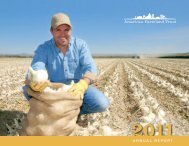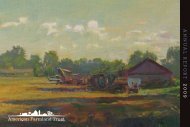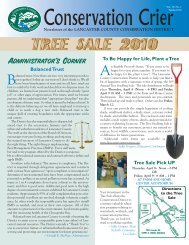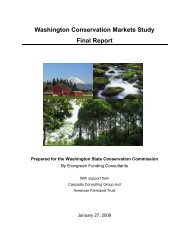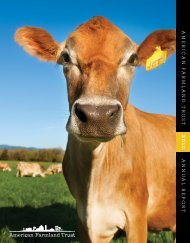Agricultural Landowners Guide Agricultural Landowners Guide
Agricultural Landowners Guide Agricultural Landowners Guide
Agricultural Landowners Guide Agricultural Landowners Guide
You also want an ePaper? Increase the reach of your titles
YUMPU automatically turns print PDFs into web optimized ePapers that Google loves.
the Southeastern U.S., thrives in open older pine stands<br />
maintained by controlled burning. <strong>Landowners</strong> can<br />
create individual management agreements with the<br />
DNR to conduct practices beneficial to improving<br />
RCW habitat. As long as the landowners follow the<br />
management plan, they will not be required to comply<br />
with any additional restrictions (as generally required<br />
under the Endangered Species Act) should the RCW<br />
population increase. In addition, landowners may be<br />
eligible for cost-share assistance for implementing the<br />
management plan.<br />
For information, contact the U.S. Fish and Wildlife<br />
Service.<br />
Scenic Rivers Stewardship Program<br />
The Scenic Rivers Program began in 1989 to encourage<br />
a voluntary, community-based approach to conservation<br />
goals along the state’s waterways. If the General<br />
Assembly designates the river as a State Scenic River,<br />
landowners and other interested community partners<br />
work together to develop a scenic river management<br />
plan to suggest long-term strategies to protect the<br />
beauty of the river corridor. Individual landowners can<br />
participate in this program in several different ways.<br />
These range from voluntary registration of their land to<br />
a management agreement to donation of a conservation<br />
easement or a piece of land.<br />
For information, contact the South Carolina<br />
Department of Natural Resources.<br />
Wetlands Reserve Program<br />
Authorized by the 1996 Farm Bill, the Wetlands<br />
Reserve Program (WRP) provides landowners with<br />
technical and financial assistance to protect, restore and<br />
enhance wetlands on their property. <strong>Landowners</strong> can<br />
receive as much as 100 percent of the appraised agricultural<br />
market value of the property for permanent<br />
conservation easements or 75 percent for 30-year<br />
easements. They also can participate in a restoration<br />
cost-share agreement. These 10-year agreements pay for<br />
75 percent of the cost of restoration activities and do<br />
not place an easement on the property. Eligible land<br />
includes wetlands cleared or drained for farming or<br />
pasture and must be restorable and suitable for wildlife.<br />
The South Carolina NRCS accepts applications for<br />
WRP on a continuous basis.<br />
For information about the Wetlands Reserve Program,<br />
contact an NRCS representative at your local USDA<br />
Service Center.<br />
Wildlife Habitat Incentives Program<br />
Authorized by the 1996 Farm Bill, the Wildlife Habitat<br />
Incentives Program (WHIP) provides cost-share assistance<br />
and technical assistance to develop and improve<br />
habitat for fish and wildlife on private land.<br />
<strong>Landowners</strong> work with the NRCS to create wildlife<br />
habitat management plans that list the goals and practices<br />
needed to improve wildlife habitat. As part of their<br />
conservation plans, landowners agree to implement<br />
habitat practices and maintain the enrolled acreage for<br />
a period of five to ten years. In exchange, NRCS provides<br />
up to 75 percent in cost-share assistance to implement<br />
the plan. A contract cannot exceed a maximum of<br />
$10,000 in cost share. Interested producers may file an<br />
application at any time with the South Carolina NRCS.<br />
In South Carolina, WHIP is a competitively ranked program<br />
in which applications with the highest wildlife<br />
benefits receive priority for funding.<br />
For information about the Wildlife Habitat Incentives<br />
Program, contact an NRCS representative at your local<br />
USDA Service Center.<br />
Photo: Clemson University Public Service and Agriculture<br />
15



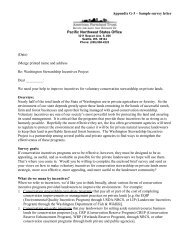


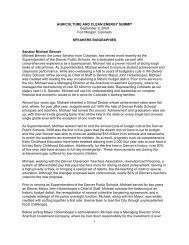
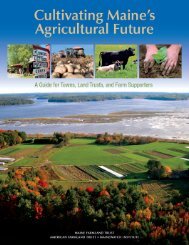
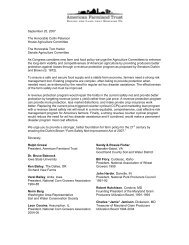
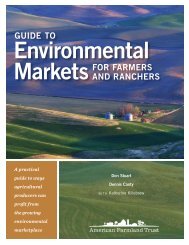
![Farmland by the Numbers [PDF] - American Farmland Trust](https://img.yumpu.com/31549391/1/190x245/farmland-by-the-numbers-pdf-american-farmland-trust.jpg?quality=85)
